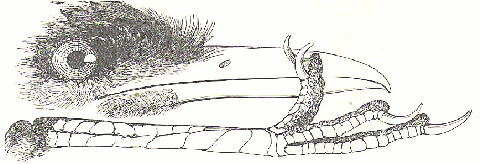|
So called from the chaparral or dwarf forest which it frequents,
the Chapparal Cock was the name commonly given by English-speaking settlers
in the south-western districts of North America to a curious form of Cuckoo,
forming the genus Geococcyx,within which there are two species.
Both are more commonly known today as Road Runner. The first, described
by Hernandez (Hist. Anim. Nov. Hispan. p. 25, cap. lii.) under the
name of Hoitlallotl,
and then identified by Buffon with the Paraka
of
Barrere (France Equinox. p. 140), was mistaken by Latham for the
Parraqua
drawn by Bajon in 1777 (Mem. pour l'hist de Cayenne,
i. p. 374,
pl. i.), and became the Phasianus mexicanus
of Gmelin.
This, being the southern form, is presumably that which is usually nowadays
called the Lesser Roadrunner (Geococcyx
velox).
The second, a larger bird, inhabits New Mexico
and the adjacent part of the United States of America, and, under the name
of Saurothera californiana,
was described by Lesson
(Compl. Buffon,
vi.
p. 420) as one of the most interesting discoveries of (then) modern times.
This bird is the Greater Roadrunner,
(its latin scientific name now being Geococcyx californianus)
The habits of both seem to be very similar and
very remarkable.They have short wings, and seldom fly unless suddenly surprised,
but use their long legs to run with great speed, bearing their lengthy
tail erect. Their feet have two toes at the front and two pointing behind
(known as zygodactyl feet).

Picture of Roadrunner or Chapparal
Cock showing beak and zygodactyl feet
Like others of their Family in the New World
they build their own nests, though clumsily, and lay therein from two to
four white eggs. When tamed, as these birds often have been, they become
expert mousers, but are so mischievous, says Mr. Dresser (Ibis, 1865,
p. 467), as hardly to be suffered in a house. The name Paisano (countryman)
by which this species is known in some districts is said to be a corruption
of Faisan
(Pheasant). The osteology of the species was minutely
described by Dr. Shufeldt (Journ. Anat. and Physiol. xx pages
246-266, pls. vii-ix and xxi. pages 101-102).
|





